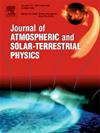Spatio-temporal variation of particulate matter (PM10) concerning the COVID-19 pandemic in the major cities of Uttarakhand, India
IF 1.9
4区 地球科学
Q3 GEOCHEMISTRY & GEOPHYSICS
Journal of Atmospheric and Solar-Terrestrial Physics
Pub Date : 2025-02-19
DOI:10.1016/j.jastp.2025.106464
引用次数: 0
Abstract
The present investigation focuses on one of the principal air quality parameters, Particulate Matter (PM10), in some of the major cities of Uttarakhand, viz. Haridwar, Dehradun, Rishikesh, Kashipur, Rudrapur, and Haldwani during 2011–2020. In the year 2020 (from 22nd March to September), the lockdown was implemented worldwide due to the COVID-19 pandemic, which resulted in a considerable decrease in air pollutants globally and nationally. Understanding the ambient air quality of Uttarakhand requires analyzing PM10 variability in these cities, which are among the most populated and industrialized in the state. Hence, a decadal study explains the change in air quality with every changing year. The observed PM10 concentration was 2–3 times higher than the prescribed limits (60 μgm−3) fixed by the Central Pollution Control Board (CPCB) in New Delhi, India. The highest (251.8 μgm−3) PM10 concentration was observed in the winter season (2011) as compared to other seasons in Dehradun city. The PM10 concentration was observed to be high during this decadal period except in 2020 due to the COVID-19 lockdown. A negative correlation coefficient was observed when correlated with rainfall and humidity, while a positive correlation was observed when correlated with temperature for all the sampling sites. The calculated p-values for PM10 and meteorological parameters for Haridwar, Dehradun, Rishikesh, Kashipur, and Rudrapur are 0.01, 0.05, 0.01, 0.05, 0.01, and 0.01, respectively.
印度北阿坎德邦主要城市新冠肺炎大流行期间颗粒物(PM10)时空变化
本次调查的重点是2011-2020年期间北阿坎德邦一些主要城市的主要空气质量参数之一——颗粒物(PM10),即哈里德瓦尔、德拉敦、里希凯什、卡什普尔、鲁德拉普尔和哈尔德瓦尼。2020年(3月22日至9月),由于COVID-19大流行,全球实施了封锁,导致全球和国家的空气污染物大幅减少。了解北阿坎德邦的环境空气质量需要分析这些城市的PM10变化,这些城市是该邦人口最多、工业化程度最高的城市之一。因此,一项年代际研究解释了空气质量随年份变化的变化。观测到的PM10浓度比印度新德里中央污染控制委员会(CPCB)规定的限值(60 μgm−3)高出2-3倍。冬季(2011年)PM10浓度最高,为251.8 μgm−3。在这10年期间,除2020年因COVID-19封锁外,PM10浓度都很高。所有样点与降雨、湿度均呈负相关,与温度均呈正相关。哈里德瓦尔、德拉敦、里希凯什、卡什普尔和鲁德拉普尔的PM10和气象参数的p值分别为0.01、0.05、0.01、0.05、0.01和0.01。
本文章由计算机程序翻译,如有差异,请以英文原文为准。
求助全文
约1分钟内获得全文
求助全文
来源期刊

Journal of Atmospheric and Solar-Terrestrial Physics
地学-地球化学与地球物理
CiteScore
4.10
自引率
5.30%
发文量
95
审稿时长
6 months
期刊介绍:
The Journal of Atmospheric and Solar-Terrestrial Physics (JASTP) is an international journal concerned with the inter-disciplinary science of the Earth''s atmospheric and space environment, especially the highly varied and highly variable physical phenomena that occur in this natural laboratory and the processes that couple them.
The journal covers the physical processes operating in the troposphere, stratosphere, mesosphere, thermosphere, ionosphere, magnetosphere, the Sun, interplanetary medium, and heliosphere. Phenomena occurring in other "spheres", solar influences on climate, and supporting laboratory measurements are also considered. The journal deals especially with the coupling between the different regions.
Solar flares, coronal mass ejections, and other energetic events on the Sun create interesting and important perturbations in the near-Earth space environment. The physics of such "space weather" is central to the Journal of Atmospheric and Solar-Terrestrial Physics and the journal welcomes papers that lead in the direction of a predictive understanding of the coupled system. Regarding the upper atmosphere, the subjects of aeronomy, geomagnetism and geoelectricity, auroral phenomena, radio wave propagation, and plasma instabilities, are examples within the broad field of solar-terrestrial physics which emphasise the energy exchange between the solar wind, the magnetospheric and ionospheric plasmas, and the neutral gas. In the lower atmosphere, topics covered range from mesoscale to global scale dynamics, to atmospheric electricity, lightning and its effects, and to anthropogenic changes.
 求助内容:
求助内容: 应助结果提醒方式:
应助结果提醒方式:


